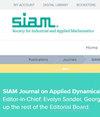论随机 SINDy 的高阶漂移和扩散估计值
IF 1.8
4区 数学
Q2 MATHEMATICS, APPLIED
引用次数: 0
摘要
SIAM 应用动力系统期刊》,第 23 卷第 2 期,第 1504-1539 页,2024 年 6 月。 摘要.非线性动力学稀疏识别(SINDy)算法可应用于随机微分方程(SDEs),使用来自 SDE 实现的数据估计漂移和扩散函数。SINDy 算法需要每个函数的样本数据,而样本数据通常是通过状态数据进行数值估计的。我们分析了之前提出的漂移和扩散函数估计值的性能,给出了有限数据的误差界限。然而,由于这种算法只有在采样频率和轨迹长度都达到无穷大时才会收敛,因此在一定容差范围内获得近似值可能是不可行的。为了解决这个问题,我们开发了精度更高的估计值,供 SINDy 框架使用。对于给定的采样频率,这些估计值能给出更精确的漂移和扩散函数近似值,从而使 SINDy 成为更可行的系统识别方法。本文章由计算机程序翻译,如有差异,请以英文原文为准。
On Higher Order Drift and Diffusion Estimates for Stochastic SINDy
SIAM Journal on Applied Dynamical Systems, Volume 23, Issue 2, Page 1504-1539, June 2024.
Abstract.The sparse identification of nonlinear dynamics (SINDy) algorithm can be applied to stochastic differential equations (SDEs) to estimate the drift and the diffusion function using data from a realization of the SDE. The SINDy algorithm requires sample data from each of these functions, which is typically estimated numerically from the data of the state. We analyze the performance of the previously proposed estimates for the drift and the diffusion function to give bounds on the error for finite data. However, since this algorithm only converges as both the sampling frequency and the length of trajectory go to infinity, obtaining approximations within a certain tolerance may be infeasible. To combat this, we develop estimates with higher orders of accuracy for use in the SINDy framework. For a given sampling frequency, these estimates give more accurate approximations of the drift and diffusion functions, making SINDy a far more feasible system identification method.
Abstract.The sparse identification of nonlinear dynamics (SINDy) algorithm can be applied to stochastic differential equations (SDEs) to estimate the drift and the diffusion function using data from a realization of the SDE. The SINDy algorithm requires sample data from each of these functions, which is typically estimated numerically from the data of the state. We analyze the performance of the previously proposed estimates for the drift and the diffusion function to give bounds on the error for finite data. However, since this algorithm only converges as both the sampling frequency and the length of trajectory go to infinity, obtaining approximations within a certain tolerance may be infeasible. To combat this, we develop estimates with higher orders of accuracy for use in the SINDy framework. For a given sampling frequency, these estimates give more accurate approximations of the drift and diffusion functions, making SINDy a far more feasible system identification method.
求助全文
通过发布文献求助,成功后即可免费获取论文全文。
去求助
来源期刊

SIAM Journal on Applied Dynamical Systems
物理-物理:数学物理
CiteScore
3.60
自引率
4.80%
发文量
74
审稿时长
6 months
期刊介绍:
SIAM Journal on Applied Dynamical Systems (SIADS) publishes research articles on the mathematical analysis and modeling of dynamical systems and its application to the physical, engineering, life, and social sciences. SIADS is published in electronic format only.
 求助内容:
求助内容: 应助结果提醒方式:
应助结果提醒方式:


